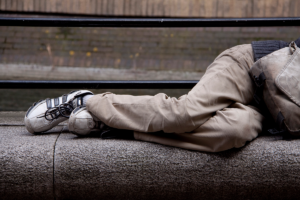Homeless Prevention Financial Guide: The Money Guide to Preventing Homelessness

Things Everyone Should Know About Credit Cards
03/11/2024
Snowball vs. Avalanche: What Is the Best Way to Pay Off Debt?
03/19/2024One of the most distressing problems in America today is people living without roofs over their heads. In major cities, you see it all the time. And there are half a million people who are homeless living in America, with 30% of those people living in California. However, knowing the factors that lead to homelessness can help you avoid becoming homeless. If you’re struggling to make ends meet, know that you are not alone. More than half of Americans cannot afford a $400 emergency. They’re one disaster away from becoming homeless. But with proper money management and good support systems, you can take steps to avoid becoming homeless.
What Current Homeless Demographics Tell Us About Homeless People
The University of California, San Francisco did a study on homelessness in California and their findings were astounding. Some of the facts are as follows:
- Minority groups are overrepresented
- Stress and trauma tend to predate homelessness
- Nearly three-quarters of homeless individuals experienced physical violence
- Nearly one-quarter experienced sexual violence; the number increased for women and nonbinary individuals
Why Are People Homeless?
The study also looked at why people are homeless. A high percentage of people were rent burdened or entered homelessness after being released from an institution. They were also not given adequate time to find new housing. Leaseholders were given an average of 10 days and non-leaseholders an average of one day. Neither group made an adequate amount of money, but their reasons for leaving their housing were different. Leaseholders left their housing for economic reasons while non-leaseholders left their housing for social reasons.
What’s most interesting about this study is that people who were homeless believed that financial support in the form of $300-$500 a month or a lump sum of $5000-$10,000 would have prevented or postponed their homelessness. While we don’t have universal basic income, that small amount of money could make a huge difference in the lives of people living at or below the poverty level.
Evaluate Homeless Risk Factors
This study found that contrary to the narrative that all homeless people are on drugs and would choose their addiction over housing, many people simply didn’t make enough money to remain housed. Leaseholders made an average of $1400 a month and non-leaseholders made an average of $960 a month.
5 Financial Strategies for Homeless Prevention
There are ways to help prevent homelessness, such as the five strategies we’ll explore below.
1. Challenge: High Housing Costs—Plan: Limitation
Those who experienced homelessness were more likely to be low income than those who had not experienced homelessness, with the median incomes being between $960 and $1400 a month. Living with housing costs that are more than 50% of your household income puts you at greater risk of homelessness. With those monthly salaries, it’s important to try and still live within your means if at all possible. That will help you fight homelessness. How do you do that?
- Apply for government subsidies for housing. Many places have housing vouchers that allow you to live in reduced-income areas. While their waiting lists are long, get on one anyway. You never know when a spot is going to open up.
- Live with roommates. Roommates significantly decrease the amount of money you spend on housing because they allow you to split housing costs.
- Use intergenerational living. Intergenerational living is when multiple generations of the same family live together and split the bills. My family lives like this, and to make things cheaper, each of us buys one dinner a week and then we eat the leftovers for lunch.
The ultimate goal is to understand what you can and cannot afford and develop a plan to spend only what you can afford. A good rule of thumb is to not spend more than 30% of your income on housing. That might take some social engineering with friends and family to make work, but it’s possible. I live in a house with seven people, and we each pay $250 a month for rent.
2. Challenge: Access to Quality Care—Plan: Prevention
Communities without access to quality care more often produce homeless people even though according to the study, 83% of people experiencing homelessness had access to Medicare. Make sure you’re getting all the preventative care that you have access to. Try to avoid the emergency room and go to urgent care and primary care doctors instead.
If you don’t have healthcare, take advantage of subsidized healthcare programs like Healthcare.gov. You can get reduced or free healthcare from that website depending on your income and access to employer-sponsored healthcare.
Let’s Talk About Mental Health

Many people struggling with mental health and addiction wind up homeless because they cannot find access to care. The barrier of entry to receive these services is high. Find a local social worker who will help you navigate the system. Social workers are excellent people who have a heart for service and want to help you find the care you need. You can call the resource center of your work to help you navigate plans.
Preventative Treatment and Caring for Your Body
Caring for your body is so important when it comes to remaining healthy. If you have a chronic health condition, like bipolar disorder, making sure you take your medication regularly is crucial to having a happy, healthy life. If you cannot afford your meds, there are ways to write to the drug companies and ask for subsidization of your medications for at least a year. This reduced cost in your budget will allow you to save for the next year.
3. Challenge: Nutritious Food—Plan: Prioritization
Communities with poor nutrition are more likely to produce homeless people. Nutrition is very important to living a good life, and staying out of homeless situations. Take control of your health and stop prioritizing unhealthy outcomes like fast food. Instead, learn how to cook and share meals with friends and family to cut costs. Meal prep.
What Is Meal Prepping?
Meal prepping is when you plan all your meals out for the week. It doesn’t have to be elaborate. My meal prep costs me about $25 a week, but your mileage may vary depending on where you live. I buy one meat, one vegetable, and a starch (like rice or potatoes). I explore seasonings with them and I pack them all away for lunches to be had during the week. It’s a delicious and cheap way to get your food.
A lot of people think meal prepping has to be elaborate and expensive. It doesn’t. You can even spice up some basic ramen with frozen or canned veggies, which are affordable alternatives to fresh veggies that provide the same vitamins and nutrients.
What if I Struggle to Afford Food?
If you struggle to afford food, check with your local church. See if they have a food pantry. My family went to food pantries growing up to ensure we had proper nutrition. Also, buy cheaper food items. Often, a whole chicken is going to be cheaper than chicken breasts per pound. Cooking in bulk and freezing food for later is also a great way to save money.
If you live in a food desert, things might be a bit trickier. Go to your local library and see if they have a social worker on staff. Libraries are a great resource in general for all kinds of community needs.
4. Challenge: Past Disenfranchisement—Plan: Community
When I was homeless, it was my community who helped rehouse me. I was given a 30-day notice at the house I was living in at the time and needed a place to stay. My pastor and his wife housed me for a few nights, and then a professor at work helped me find temporary housing for a few weeks. It wasn’t perfect and I had to live in my car for a bit while looking for stable housing, but those two instances helped get me back on my feet.
You need to have that same kind of community. Ask yourself where you can find community and start going there. Check Facebook groups and attend local churches or community centers. If you’re LGBTQ+, there are plenty of nonprofits that help queer individuals back on their feet.
5. Challenge: Economic Opportunities—Plan: Diversification
Let’s talk about budgeting. In order to avoid homelessness, you need to spend less than you make. My favorite financial tool is the 50/30/20 rule. Spend 50% on your needs, 30% on your wants, and 20% on savings and debt payoff. However, I know that might not be realistic. So how do we create a realistic budget?
-
- Track your spending. Tracking your spending will show you how much you’re spending and on what. I recommend the app Rocket Money. Connect it to your debit card and it’ll tell you all the bills you’re paying and how much money is going where. From there you can start to see what categories you’re spending a lot on.
- Decide what spending is useful and what isn’t. A lot of people also call this spending on your values. For instance, last month I spent $36 on McDonald’s. I thought I only went once or twice, but that money really added up over the month and put me behind on my savings goals. I made an intention for the next month to eat out at McDonald’s less. And I’ve stuck to it.
- Put together your spending plan. A spending plan is a plan for your money to go to certain places. I put together all my fixed monthly bills in one spot and then I go from there. I add things that are important to me like a $70 gym membership that I split with two other people and $100 for horseback riding that’s helpful for my mental and physical health. Your spending plan can be as detailed as you want it to be. I find that the more detail I add, the more I’m able to stick to the plan.
- Start celebrating the small wins. When I first started saving money, I could save $5 to $10 a week. It wasn’t much, and I hated that. But over time, I started being able to save a bit more. Now I save $200 a month working at a nonprofit and as a freelancer. It still isn’t as much as I’d like, but it’s something. We all have to start somewhere.
- Review your spending plan every month. Look back on your budgeting and see where you did a good job. I got excited when I saw my McDonald’s spending down to nothing from March to May when I decided to cut it out of my financial diet. But I saw that my Starbucks spending had increased. Whoops. It’s not all perfect. But small changes add up to quite a big difference that could prevent you from being out on the street.

Getting a Side Hustle
Side hustles allow you to get creative with your money.
I freelance as a side hustle and make a generous amount of extra money each month that goes to paying off my debt.
You can also consider making and selling things at local fairs or online. The possibilities are endless. If you need help getting started consider going to iliketodabble.com for ideas.
Key Takeaways
Being homeless isn’t inherently wrong. It just means you didn’t have the financial resources you needed to stay afloat. There’s nothing shameful about that. And it’s okay to ask for help.
Invest in yourself. If you can find a way to make some extra money, I guarantee it’ll make a world of difference.







